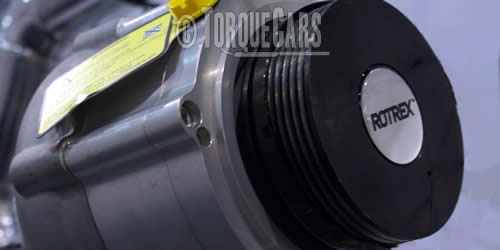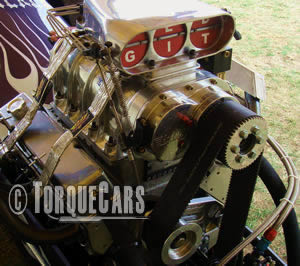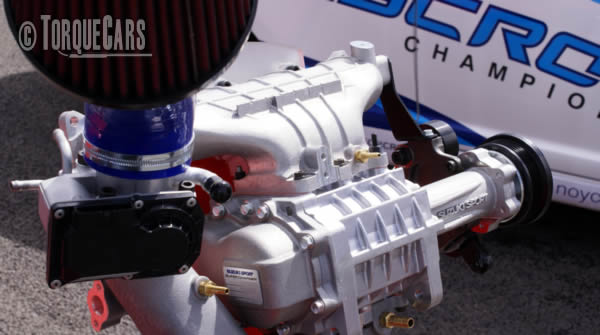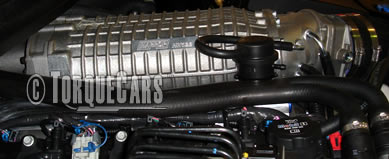Adding a supercharger - the advantages and disadvantages.
"SuperCharge me."
Superchargers offer the promise of substantial power gains with very few drawbacks. So lets look at the growing popularity of supercharger kits and see what its all about.
A supercharger is quite simply an air compressor which helps push more air into an engine.
These are driven by a belt from the engine effectively creating pull on the engine sapping up to 30% of the engines power.

For this reason superchargers are not as efficient as turbo chargers, which are driven from 'spare' energy taken from waste exhaust gases.
For tips on adding a supercharger to your car you'll need this article.
The advantages of superchargers
The big advantage for superchargers is that they produce additional power from much lower engine speeds and do not suffer from the inherent lag of turbos.
Because they are directly driven by the engines crank, as the RPM increases on the engine it also increases in the supercharger. The benefits of a supercharger are the lack of low down lag and the linear delivery of boost.
Plus they don't need an oil supply (usually) and require less pipework that turbochargers, as you are only dealing with the intake charge pipe.
Types of superchargers
There are two main types of supercharger, a positive displacement supercharger, which gives a fairly constant level of boost making tuning a much simpler process, and dynamic compressors, which provide boost in proportion to the engines speed.
Roots Superchargers
These are the oldest superchargers and have two rotors that are driven by a crankshaft through a belt.
The rotors rotate in opposite directions so the air entering the roots supercharger is pushed towards the side of the housing whereas meanwhile, the rotors mesh together to prevent air from going back.
Pros
The best feature of Roots superchargers is their abundant low-end torque and ease of installation. Besides this, these are the cheapest superchargers.
Cons
Their peak horsepower can’t match that of a centrifugal supercharger. Furthermore, they are not as efficient as twin-screw superchargers.
Centrifugal Superchargers
This is the most common type of supercharger found in modified vehicles. A very limited number of vehicles came with factory fitted centrifugal superchargers.
Such superchargers work on the principle that an impeller spins at high speeds to pull air into a tiny compressor housing.
The high-speed air has a low pressure which is passed through a diffuser that completely modifies the air’s properties by reducing its speed and increasing the pressure.
Pros
The biggest advantage of a centrifugal supercharger is that it is the easiest supercharger to operate with an intercooler.
The centrifugal superchargers offer higher top-end horsepower than the roots and twin screw superchargers.
Such superchargers are particularly useful due to their linear power delivery. Therefore, as the RPM increments, the boost pressure also rises.
Cons
The centrifugal superchargers are more complex than other types and thus their repair and maintenance is much difficult. Furthermore, they feature really low torque figures at low RPM values.
These are best used in fuel injected applications, and offer good gains when setup correctly, but can be challenging to install on older carb fed engines.
Twin Screw Superchargers
In a twin-screw supercharger, both rotors have different styles and shapes so one rotor meshes inside the other thereby compressing the air. This air then leaves the supercharger’s exit point.
Pros
The unique design of the twin-screw superchargers ensures huge amounts of low-end torque which means that car’s get improved acceleration.
Further to that, this type is very easy to install while also being much more efficient than the Roots supercharger.
Cons
The added performance comes at a cost and thus the twin-screw superchargers are more expensive than roots superchargers.
It is also worth noting that the peak horsepower of this type of supercharger is much less than that of centrifugal superchargers – the trade off for low end power gains.
Positive Displacement Supercharger
A positive displacement supercharger maintains the quantity of air or liquid that it pumps during each revolution.
This means that if the amount of substance entering the supercharger is one liter, the output will also be one liter, unlike the variable displacement supercharger in which the output depends upon the speed. Such superchargers move more volume at higher speeds and less volume at lower speeds.
The positive displacement superchargers feature a wide torque curve meaning that an effective boost is provided across a wide range of RPMs.
Roots and twin screw superchargers are examples of positive displacement superchargers.
Dynamic Compressors
Dynamic compressors also known as turbo compressors excel at providing ample amounts of horsepower.
They are available in radial and axial designs. The dynamic compressors having radial designs are known as centrifugal compressors.
Dynamic compressors operate at constant pressure, this distinguishes them from displacement compressors, which operate at constant flow rates.
Choosing A Supercharger For Your Project
While choosing a supercharger depends upon the purpose and intention of your project, here are a few important aspects you need to keep in mind while making the decision.
Price
Centrifugal superchargers are the cheapest whereas the prices of twin-screw and roots superchargers are usually higher due to the expensive blowers.
If you are on a tight budget, consider going for a roots supercharger.
Street Legal Or Not
The roots supercharger is the best option if you want a street-legal car.
The noisy nature of twin-screw superchargers makes them badgering for daily usage and thus might not be street legal in every area.
So if you are worried about the longevity of your car’s parts, try to avoid the twin-screw supercharger.
Wear & Tear
The centrifugal supercharger is the best option if you want to put the least amount of strain on your car's transmission and other components for improving their life.
This supercharger is also most suited for street cars as it doesn’t have high power at low RPM which provides additional control over the car.
Fuel Economy
Both roots and twin screw superchargers have bypass valves that provide an alternate route to air for bypassing the rotors during low load operations.
This improves the fuel economy when a supercharger is not needed for example while cruising on the highway.
This means that you can select a low load operation mode with both roots and twin screw superchargers.
Because they produce more boost, twin-screw superchargers are more efficient than roots superchargers.
Amount Of Heat Generated
Another important factor to consider when selecting a supercharger is that if your twin-screw supercharger lacks a bypass valve, it will always compress air, generating more heat and potentially damaging parts more frequently.
This is not the case with roots supercharger which doesn’t compress air internally, but rather squishes the air into the intake.
Size
Both roots and twin-screw superchargers are large components so the vehicle under consideration must have enough space if you want to fit one of these.
If your vehicle doesn't have this much space, try to avoid them because you won't be able to fit them in your car.
What Should A Good Supercharger Kit Include?
Knowing what a good supercharger kit must have can mean the difference between finishing your project successfully or entirely abandoning it.
So, here we discuss all that is or at least should be included in a good supercharger kit.
- Helical gears which help in reducing the noise;
- Billet main bracket made up of aluminum to reduce the overall weight of the kit;
- Hand-held programmer that comes with a preloaded tune;
- Mass air extender;
- Crank pulley;
- Intercooler for reducing the temperature of compressed air;
- Additional fuel pump;
- Bypass valve which allows releasing the excess pressure;
- Charge piping to flow the air from the blower into the intercooler and then back.
- Fitting a supercharger
It is better to fit a supercharger to a Naturally aspirated engine than going for a turbo because you will have much more control over the power and it will be delivered in a more consistent manner establishing a good base for ECU tuning to take full advantage of the power.
 If adding forced induction to a standard naturally aspirated engine, a word of caution about engine knock.
If adding forced induction to a standard naturally aspirated engine, a word of caution about engine knock.
This is where pressure in the engine causes the air/fuel to prematurely ignite causing extensive engine damage.
Just as with a turbo you would need to lower the compression ratio of the engine in relation to the amount of boost you are putting into the engine.
Ideally you want to lower the compression of an engine to around 8:1 to allow a reasonable level of boost, although this varies from application to application and with water injection this can be safely exceeded. Using higher octane fuel will also help to reduce the risk of detonation.
Typically superchargers are more expensive to make than turbo chargers. As demand increases these costs will eventually come down to affordable levels and after market kits will be available for most popular engines.

The other advantage of a supercharger is that the charge temperature is substantially lower than an equivalent turbo application and cooler air carries more oxygen which means more fuel can be burned therefore releasing more power.
Any form of compression of air creates a temperature rise so an intercooler is still a good idea on a supercharged engine. You will also need to uprate your fuelling.
Twincharged setups with turbos and superchargers
Manufacturers are now producing dual forced induction systems. These give a good compromise between low down boost and top end power.
Offerings such as Volkswagens 1.4 twincharger engine can produce a massive 168hp and 177 lb-ft torque, and still return fuel consumption around 40mpg. A smaller engine is also lighter and smaller so fairly small cars can be fitted with these engines and offer very good performance.
Bear in mind that twincharging compounds the power gains, so a (10psi Turbo + 10psi Supercharger will flow just under 30psi of boost!)
This is due to the fact that the second set of compression is on already compressed air, so you get a much greater end pressure increase and a resultant increase in temperature.

As modern engines are so well built there is a lot of scope for the addition of forced air induction without dramatically impairing reliability.
The supercharger is also an easier bolt on upgrade when compared with a turbo.
There are also some interesting projects around where superchargers are being added to turbo engined cars to provide the best of both worlds.
Join us in our forum to see which mods our members rate and swap ideas and plans for your tuning project. TorqueCars are a friendly forum and all makes and models, and all levels of technical ability are welcome. Join here.
Please Check out my YouTube channel, we're regularly adding new content...
PLEASE HELP: I NEED YOUR DONATIONS TO COVER THE COSTS OF RUNNING THIS SITE AND KEEP IT RUNNING. I do not charge you to access this website and it saves most TorqueCars readers $100's each year - but we are NON PROFIT and not even covering our costs. To keep us running PLEASE Donate here
If you liked this page please share it with your friends, drop a link to it in your favourite forum or use the bookmarking options to save it to your social media profile.
Feedback - What do You Think?
Please use our forums if you wish to ask a tuning question, and please note we do not sell parts or services, we are just an online magazine.
Help us improve, leave a suggestion or tip
Please watch this video and subscribe to my YouTube channel.
2 Responses to “A guide to supercharger kits: benefits vs disadvantages”

 Click to accept YouTube Cookies & Play.
Click to accept YouTube Cookies & Play.
Hi there, in this new world where turbos have come a long way would u still say that a s\c is better then a turbo. I only ask becouse I wonder if I should put 1 in my car. I have a 2005 lancer ralliart, there’s a shop really close to me who specialize in turbos, they say turbo but they just want custumors. I found a ppackage for my car at RIPP s\c its a v6 tuners pack, what do u think would be the best choice for reliability for my car n why. Thx so much in advance
The boost rise from a SC will always be linear while the turbo boost rise can vary wildly depending on the turbine housing size.